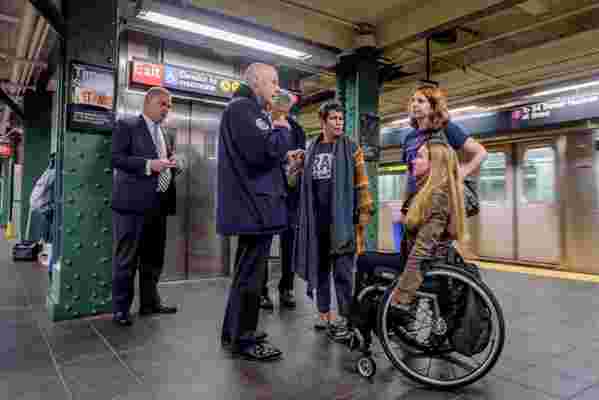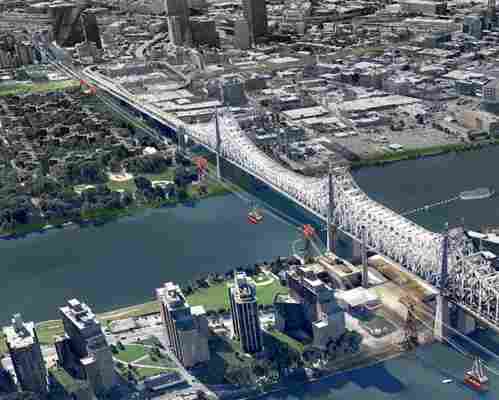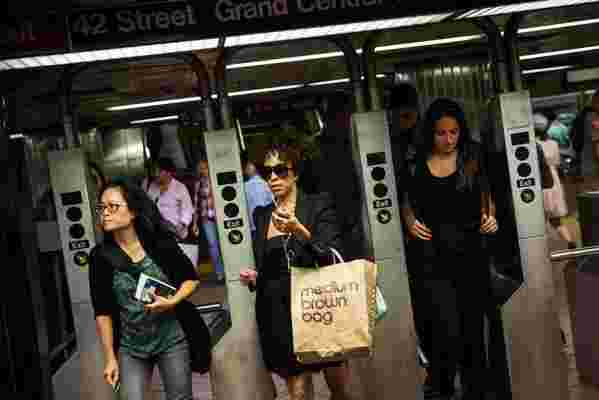That New York City's public transit system helped make it America’s financial capital feels ironic now, even painful to acknowledge. Subway trains have been in a “state of emergency” for a year, and pressure on the already crippled transit system will only intensify when an entire subway line is shut down for repairs next year.
Although the need for transit has only increased as our population burgeons, subway ridership has been falling for about two years, causing fare revenue to drop and in turn making it harder to pay for repairs. On a recent Friday, Standard & Poor’s downgraded the credit rating of the Metropolitan Transportation Authority, which administers the subway, due to “cash and debt-service coverage ratio pressures.” It feels like commuters are in an endless feedback loop of insult and injury—one which they pay for. Only the Mets baseball team can disappoint New Yorkers more spectacularly.
Given the system’s dismal status, the cheery, earnest presence of newly appointed MTA president Andy Byford is almost jarring.
“I will give it a red-hot go!” was Byford’s reply when Governor Andrew Cuomo asked him if he was really up for the job, Byford himself reports . The MTA president then rode every subway and bus route in the city, chatting with MTA workers about every aspect of their jobs along the way, all, we’re told, with the type of positive attitude that might’ve gotten you beaten up in middle school.
“Andy’s a breath of fresh air,” says Scott Rechler, former vice chairman of the Port Authority and now a member of the MTA board. “He doesn’t lead from an ivory tower,” but he does welcome new ideas, according to Rechler, in effect hopscotching around the cultural and political land mines that took out his predecessors.
He’s also good at forging relationships he can then later leverage.

Activists from the Elevator Action Group with Rise and Resist took a subway ride with NYCT President Andy Byford (middle) this spring.
“He’s used to a rough-and-tumble political environment,” says John Orcutt, the former policy director for the New York City Department of Transportation and now director of advocacy at the nonprofit Transit Center. “He can broker a deal with the Toronto mayor,” referring to the late Rob Ford, notorious for taking drugs while on camera.
Imported from Toronto by way of London, Byford is credited with turning around systems in comparably dire shape. His appointment this past December was the most substantive action to address New York’s worsening transit in decades.
“[The MTA was] spending billions, with no checks and balances,” Orcutt says. “There was no one at the top keeping track—until now. Byford’s arrival signals a new day.”
He has also signaled that he wants to remake the very institution of the MTA, and by extension its image, which is crucial to its success (more on that later). His plans have even sparked MTA workers’ hope that they won’t always be “the whipping boy” for commuters’ frustrations, Orcutt says. Of course, to call this a tall order would be like calling the subway system at the moment “suboptimal.”
FAST FORWARD (EMPHASIS ON FAST)
In May, Byford released his “ Fast Forward: The Plan to Modernize New York City ,” which suggested a cornucopia of improvements: upgrading every subway line to communications-based control, improving wheelchair accessibility, thoroughly studying the bus system and then overhauling it, and adopting a more efficient fare collection system.
“It’s very…ambitious,” Rechler says. “It’s the first time we’ve had something this comprehensive.”
The plan sets out to accomplish in ten years what previously MTA leadership said would take 40, says Randall Morton, urban design principal at Carrier Johnson + Culture and a longtime New York City resident. “I love the aggressiveness of it.”
Of course, nothing’s perfect. Even while most observers admit Fast Forward is the best stab at this issue they’ve seen, they have some misgivings. Morton wishes it called for an extension of the Long Island Railroad to the World Trade Center transit hub, and there are concerns that Fast Forward doesn’t go far enough in terms of accessibility for the disabled. (On Byford’s subway tour he meets with accessibility activists who remind him that the elevators they rely on unfortunately double as bathrooms for the homeless.) Others wish it addressed the integration of micro-transit, which can serve at least as a stopgap while the subway gets back on its feet.

This rendering shows a proposal to extend the Roosevelt Island tramway out west to Central Park and east to Queens Plaza—an example of micro-transit—as a way to relieve pressure on systems such as the subway.
Morton also says the visual universe of the subway system could use sprucing up—stations have incorrect or misleading signage, some have none at all, and service change notices are often bewildering even to natives. Improving the visual package and conveying more information could “stop the anxiety” that is driving riders’ backlash, he says.
And that backlash is in full effect. Recently, a pair of angry riders beat a motorman when their train switched from making local stops to run on the express track, according to news reports. Byford released a statement vowing to prosecute the perpetrators to the full extent of the law; some Twitter users were sympathetic to the assailants.
Yet by far the biggest challenge to Fast Forward is “getting the legislature to come up with the money,” as Orcutt puts it. The plan reportedly needs “vastly more” than the $32 billion MTA budget that Governor Cuomo rejected in 2015. Even Rechler, a real estate developer by trade, says the state needs to cough up the money. “[Byford] needs a sustainable, reliable flow of funds.”
Years of failure to spend enough on upkeep, combined with a fraught relationship between a state agency and the city that relies on it, have begotten this situation. Now, fixing it has the governor, New York City Mayor Bill de Blasio, and MTA brass acting like elementary school students with a rotten group assignment: No one wants the responsibility, but they’re all dreading their grade.
HOW DID WE GET HERE?
To be sure, the system has been in worse shape in previous decades, if less burdened overall. Some blame ex-Governor George Pataki for growing the MTA’s debt instead of spending cash on it. Rechler says cutbacks after the recession helped sign the subway’s death warrant.
For context, a levy that would be obscure in a smaller city plays an outsize role in funding transit in New York City: the mortgage recording tax. It generates significant revenue for the MTA despite its humble moniker. Assessed on every property purchase made with debt, from a single-family home loan to major commercial real estate trades, the tax bolstered MTA revenue appreciably when price tags for New York City office towers rose into the billions before the crash.
Then, by 2008, no one could get a loan for their kitchen remodel anymore, let alone a billion dollars to buy an office tower. A chunk of change the MTA relied on vanished. Lines and services were cut; MTA staff shrank. And before the system could recover, Superstorm Sandy hit.

People making their way through the New York City subway system at rush hour. New Yorkers deal with the longest commute to work in the United States, recent studies show.
The $5 billion the MTA got from FEMA didn’t cover improvements the beleaguered system already needed, or pay for preventative measures that Sandy had made evident were crucial. And while revenues from the now-resurgent property market certainly should have helped out, the MTA was already too deep in disrepair to make up the difference.
When Joseph Lhota, who was the MTA chairman in 2012, returned to the fold last June, he was tasked with helping the agency play catch-up. “A lot of what [Lhota’s] subway action plan was doing was reinstating the maintenance teams, the backup equipment" that had been cut during the recession, Rechler says. The MTA brought in Byford for the systemic overhaul.
The big guns made transit advocates and observers hopeful, whereas it was too late for riders. They’d already seen three new subway stops cost an alarming $4.5 billion and seen the governor make a show of installing countdown clocks in select stations—which just underscored how late trains were—while he let the crisis escalate. Then, this past December, came the revelation that subcontractors paid $1,000 per day were doing literally nothing while on the clock on the East Side Access project. Contractors and accountants questioned by The New York Times had no idea what the subcontractors were in charge of. Straphangers’ anger ossified into militant distrust and indignant rage.
That lack of trust is costing taxpayers dearly. Contractors “don’t have faith in the deadlines” the MTA puts forward, says Orcutt, and so few bid on MTA projects. They fear delays, bad publicity, and dealing with the bureaucratic bloat. With less competition, costs grow and repairs are more elusive. The feedback loop continues.
Which is why Byford’s overhaul must address contractors’ (well-earned) fears.
A station in Long Island City, Queens, shows its age—not uncommon among the network's 472 stations.
Some of the necessary revisions aren’t hard to pinpoint. Revising the agency’s contracts so that 19 people—literally—don’t have to sign off on each proposed change to a work plan is a start, and Rechler’s construction cost containment committee is addressing the issue head on. Contracts that prohibit work stoppages have also meant that work continues before a contractor can get a sign-off on a change, and then that work has to be undone. Limits on the hours when work can take place also mean subcontractors spend an hour setting up in order to do two to four hours of work, then another hour cleaning up and hauling the equipment out. Riders may have to endure longer shutdowns to make work remotely affordable or efficient, however.
Changing how the institution works is necessary for the MTA to get fixed, but it’s also important as a public acknowledgement of the agency’s previous inability—or unwillingness—to evolve.
“Internal reforms are important to the [MTA’s] message: We aren’t taking billions of dollars and using the same old team,” Orcutt says. “Byford doesn’t have a bunch of friends in the unions or the statehouse.”
MICRO-TRANSIT: COMPLEMENTARY SERVICE OR INCREMENTAL CHANGE?
Byford’s task, then, is simply to find and then preserve a sufficient revenue stream, reorient the MTA’s work culture, and deliver repairs on time and on budget, repeatedly. But even if he manages that, implementing the Master Plan will take around a decade. In the meantime, there are design and policy improvements that can alleviate the pressure on commuters and the system alike.
“There’s a huge opportunity in micro-transit,” says Adam Lubinsky, an associate professor in Columbia University’s graduate school of architecture and managing director at WXY Architecture + Urban Design. Lower cost supplements to the burdened subways, such as ride-share and dockless bikes, are a quicker expansion of the transit system and especially needed in transit-poor areas such as Brooklyn neighborhoods like East New York and parts of Flatbush, experts say. Micro-transit “can support rather than compete against” the subway and MTA buses in underserved neighborhoods, Lubinsky says.
A pair of JUMP dockless bikes sit parked on a San Francisco street corner in April, 2018. New York City has its own pilot program underway, serving select neighborhoods.
“Integrating all forms of transit—bicycles, pedestrian access…[we should] consider ferries—this should be a priority,” says Morton. While New York has come around to bikes, at long last, it still needs to learn from other cities where integration of transit systems is more developed. “Cities are redesigning their bus networks because the buses haven't changed but the cities have,” Orcutt says. Meanwhile, in New York, we’re behind even on the basics. “I bought my Dunkin’ Donuts coffee on my phone this morning,” Morton notes. Purchasing a subway card has far more steps and isn’t even always possible .
Seasoned New Yorkers have likely taken a “dollar van” to the beach or a far-flung mall, but their reliability and transparency has always been decidedly low. Which is why entrepreneur Su Sunni developed an app called Dollaride.
Sunni was inspired to streamline the van hail process after loathing his hour-plus commute to school as a kid in Brooklyn. After moving to Jamaica, Queens, where the vans were widely used—two of his uncles are dollar van drivers—Sunni realized they alleviated a striking need. He consulted with an engineer, a product designer, and a New York University professor specializing in urban transit to created Dollaride. It provides real-time information on vans in transit-poor areas, which should let him tap a market he estimates generates $70 million per year.
However, the size and reach of micro-transit is crucial for it to meaningfully change how we move around the city. “If you're going to sort of flirt around the edges…it's not going to make a blip,” Orcutt says, pointing to the city’s dockless bike pilot program currently under way, which serves select neighborhoods. He says micro-transit can become “activity in lieu of strategy” and distract from deeper issues.
SELLING RESILIENCY
A subway tunnel in the process of having water pumped out is seen in Lower Manhattan following Superstorm Sandy in 2012.
In the long term, transit outcomes rely hugely on the resiliency of the system. “There are two kinds of spending,” Morton says. “Spending you can see, and spending you cannot see.” While the latter can be a hard sell, it is often more important.
Part of the reason the subways are neglected is that there are few political points to score by prioritizing something voters take as a given. Politicians “like to focus on things that are above ground, where they can cut ribbons,” Rechler says.
The MTA needs to be bolstered in anticipation of superstorms, population shifts, climate change, and technological advancement. Focusing on the future is always difficult politically; it’s nearly impossible when voters trust has been so thoroughly broken. If the agency can prove themselves transparent and accountable, they’ll be more able to spend on resiliency without sacrificing rider or taxpayer sentiment. Perhaps a positive feedback loop is possible.
The subway did make New York a financial capital, but it can also do a lot for equality. "This is about being able to get home to that baseball game or to get the kids to bed,” Rechler says. “There is nothing more important than getting it moving effectively."
RELATED: How Architecture and Design Can Help Prevent School Shootings
